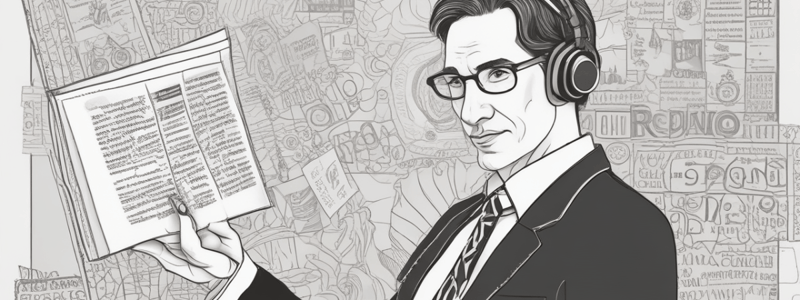Podcast
Questions and Answers
What is the main purpose of a rally speech?
What is the main purpose of a rally speech?
- To persuade the audience to take action (correct)
- To entertain the audience with humor
- To introduce a guest speaker
- To provide information about a topic
what are the two teams called in a debate?
what are the two teams called in a debate?
- The agreeers and the disagreeers
- The proposers and the opposition
- The positive and the negative
- The proposition and the opposition (correct)
What is the purpose of using rhetorical questions in a speech?
What is the purpose of using rhetorical questions in a speech?
- To provoke thought and elicit a response from the audience (correct)
- To support the speaker's own opinion
- To provide a clear answer to the audience
- To make the audience feel uncomfortable
What is the term used to describe the use of three examples in a row to make a point?
What is the term used to describe the use of three examples in a row to make a point?
What is the purpose of using direct address in a speech?
What is the purpose of using direct address in a speech?
What is the term used to describe the repetition of a certain phrase at the start of consecutive sentences?
What is the term used to describe the repetition of a certain phrase at the start of consecutive sentences?
What is the purpose of using emotive language in a speech?
What is the purpose of using emotive language in a speech?
What is the purpose of using descriptions and details in a short story?
What is the purpose of using descriptions and details in a short story?
What should you do when a new speaker begins in a dialogue?
What should you do when a new speaker begins in a dialogue?
What is the purpose of staying in the same verb tense in a short story?
What is the purpose of staying in the same verb tense in a short story?
Why should you stay in the same narrative voice in a short story?
Why should you stay in the same narrative voice in a short story?
What is the primary focus of a personal essay?
What is the primary focus of a personal essay?
What is the importance of being honest in a personal essay?
What is the importance of being honest in a personal essay?
What should you avoid in a personal essay?
What should you avoid in a personal essay?
What is the purpose of reflection in a personal essay?
What is the purpose of reflection in a personal essay?
What is the primary focus of a discursive essay?
What is the primary focus of a discursive essay?
What is a feature of a newspaper article?
What is a feature of a newspaper article?
What is the purpose of a by-line in an article?
What is the purpose of a by-line in an article?
What is the purpose of using stylistic features such as alliteration and assonance in a descriptive essay?
What is the purpose of using stylistic features such as alliteration and assonance in a descriptive essay?
Flashcards are hidden until you start studying
Study Notes
Key Features of Speech Writing
- Direct address: speaking to the audience directly, using inclusive language to engage them
- Rhetorical questions: using language to persuade, provoke thought, and elicit a response
- Triadic phrasing: using three examples in a row, e.g., "we have been bullied, harassed, and intimidated for far too long"
- Emotive language: using metaphors, similes, personification, stirring language, and perceptively chosen images to convey passion and engagement
- Repetition: repeating a phrase for effect, e.g., using anaphora to emphasize a point
Additional Techniques
- Anecdote: using a small personal story to connect with the audience and prove a point
- Undermining opposing views: imagining and addressing concerns of those who disagree
- Exaggeration: Going over the top, or using hyperbole in your writing. This might include using superlatives
Different Types of Speeches
Rally Speech
- Mention the crowd and supporters
- Mention the location, e.g., government buildings or main city street
- Speech should be stirring, rousing, and persuasive
Public Speaking Competition
- Mention the topic being spoken about
- Acknowledge competitors and usually no teammates
- Express gratitude for reaching the final stage
Debate
- Two teams: proposition (agreeing with the statement) and opposition (disagreeing)
- Greet the audience, other team, chairperson, adjudicators, and time-keeper
- Thank the teacher (if in a classroom debate)
Radio Talk
- Mention the radio station
- Provide a phone or text line for listeners to contact
- Mention upcoming programs or events
Online Broadcast
- Thank listeners for logging on
- Provide practical tips, e.g., muting microphones or switching off cameras
- Keep the tone realistic
Podcast
- Refer frequently to listeners
- Encourage liking and subscribing to the podcast
- Mention sponsors (if applicable)
- Be aware of the number of presenters (one or two)
Key Features of a Short Story
- A short story is a complete and self-contained narrative.
- The plot should match the question being asked.
- Focus on one or two main characters to maintain control and brevity.
- Keep the time-frame short to maintain a concise narrative.
- Avoid sub-plots to keep the action brief and focused.
- Consistency is key: stay in the same verb tense and narrative voice (first or third person) throughout.
- Use descriptions and details to create and enhance the atmosphere.
Using Dialogue in a Short Story
- Use double quotation marks to set off dialogue from the rest of the narrative.
- Punctuation goes inside the last quotation mark.
- Vary verb use to add tone and interest to dialogue (e.g., "cried", "whispered", "mumbled begrudgingly").
- Start a new line for each new speaker.
- When the same speaker continues, stay on the same line.
Key Features of a Personal Essay
- A personal essay is a detailed account of specific experiences with reflections on the insights gained from them.
- Features of a good personal essay include honesty, reflection, and engagement.
Importance of Honesty
- Pick a question and topic you are genuinely interested in to ensure your essay is honest and engaging.
- Don't try to write about something you are not interested in, as it will be noticeable.
Reflection in a Personal Essay
- Merely telling a story is not enough; you need to open up to the reader and consider what your feelings might mean.
- Being reflective means trying to understand your feelings, but it's okay not to have all the answers.
Engagement in a Personal Essay
- Every person is interesting in their own way, and honesty and details make an essay more engaging.
- Don't lie or exaggerate, as it will sound disingenuous and impersonal.
Planning a Personal Essay
- Plan your answer in advance to ensure a systematic approach.
- Break down the topic into sections, including description, reflection, and overcoming challenges.
Structure of a Personal Essay
- Describe the experience: when it occurred, how it manifested itself, and specific examples.
- Reflect on your feelings and what they might mean.
- Describe how you overcame the challenge, including obstacles and setbacks.
- Reflect again on the journey and how you feel now.
Summary of a Personal Essay
- The main sentiment of a personal essay should be one of reflection, looking at the journey and how you feel at the end.
Discursive Essay
- A type of essay that involves writing on a broader topic.
- May require a personal touch, as indicated by the term "personal discursive" essay.
- In a personal discursive essay, the writer is expected to share their personal feelings and opinions on a universal topic.
- The writer's personality, thoughts, and beliefs should be showcased in the essay.
Essay Structure
- Introduction should be based on the writer's own conclusion on the topic.
- Consider all sides of the argument in a logical and clear manner.
- Anecdotes can be used to support a point, but they should not be the primary evidence.
Key Characteristics
- Involves exploring different ideas associated with the topic.
- Requires a balanced and nuanced discussion of the topic.
Discursive Essay
- A type of essay that involves writing on a broader topic.
- May require a personal touch, as indicated by the term "personal discursive" essay.
- In a personal discursive essay, the writer is expected to share their personal feelings and opinions on a universal topic.
- The writer's personality, thoughts, and beliefs should be showcased in the essay.
Essay Structure
- Introduction should be based on the writer's own conclusion on the topic.
- Consider all sides of the argument in a logical and clear manner.
- Anecdotes can be used to support a point, but they should not be the primary evidence.
Key Characteristics
- Involves exploring different ideas associated with the topic.
- Requires a balanced and nuanced discussion of the topic.
Articles
- Always use a title to introduce the article
- Includes a sub-heading that sets the tone and indicates the content
- Has a by-line to identify the author
- Ends with a sign-off
- Tailored to the target audience and possibly references other sections of the publication
- May require a specific tone, such as serious or light-hearted
Descriptive Essay
- Focuses on vivid, clear descriptions of a place or time
- Does not require a plot or storyline
- Aims to engage the senses by describing sights and sounds
- Utilises various stylistic features, including:
- Assonance
- Alliteration
- Sibilance
- Imagery
- Onomatopoeia
- Personification
- Varied vocabulary to create a rich and immersive experience
Studying That Suits You
Use AI to generate personalized quizzes and flashcards to suit your learning preferences.




